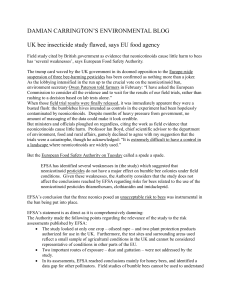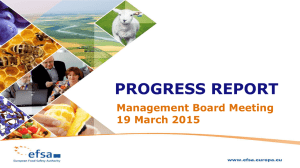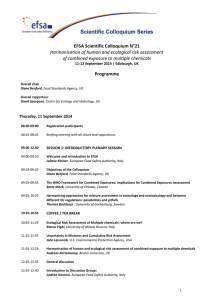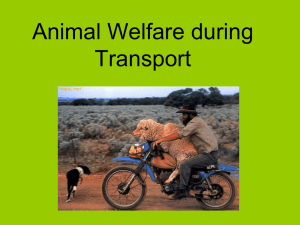EFSA activities in 2012 – 2013
advertisement
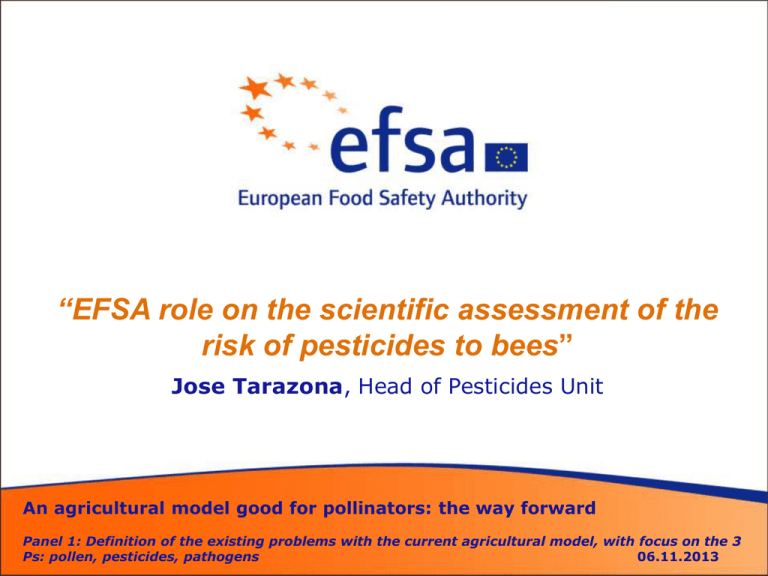
“EFSA role on the scientific assessment of the risk of pesticides to bees” Jose Tarazona, Head of Pesticides Unit An agricultural model good for pollinators: the way forward Panel 1: Definition of the existing problems with the current agricultural model, with focus on the 3 Ps: pollen, pesticides, pathogens 06.11.2013 Pesticides Unit. Regular activities Coordinates the Peer Review of active substances Provides Conclusions for single active substances to support the EU decisionmakers Supports the Scientific Panel for pesticides PPR (Plant Protection Product and their Residues). Opinions Guidance documents MRLs Reasoned Opinions Annual report Peer review (legal framework Regulation (EC) No 1107/2009) Dossier submission 1. Commenting phase PEER REVIEW (EFSA, RMS, MS, EU Commission, Notifier, Public) 2. Evaluation of comments 3. Expert’s consultation 4. Conclusion Commission DAR EFSA Standing Committee on the Food Chain and Animal Health (SCoFCAH = EC +MSs) Approval/Non Approval Neonicotinoids - Background • Approved in the European Union between 2006 and 2009 (PPPs on the market since 1991); • Numerous studies and research activities carried out in the last years; • High controversy over the risk; • Regulation (EC) No 1107/2009 under Article 21 foresees the possibility to review the approval of active substances in light of new scientific and technical knowledge and monitoring data. 4 Pesticides and bees - EFSA activities in 2012 – 2013 (1) Under Article 21, EFSA was requested by the European Commission to provide technical and scientific assistance on several issues related to the risk to bees from neonicotinoid pesticides. EFSA has published the following outputs: •Statement on the findings in recent studies investigating sub-lethal effects in bees of some neonicotinoids in consideration of the uses currently authorised in Europe (EFSA Journal 2012) •Assessment of the scientific information from the Italian project “APENET” investigating effects on honeybees of coated maize seeds with some neonicotinoids and fipronil (EFSA Journal 2012) •Evaluation of the FERA study on bumble bees and consideration of its potential impact on the EFSA conclusions on neonicotinoids (EFSA Journal 2013) 5 Pesticides and bees - EFSA activities in 2012 – 2013 (2) In 2012, EFSA has undertaken a review of the risk to bees upon receipt of a mandate from the European Commission. Key elements of the EC Mandate: • To revise the risk assessment for bees by considering: Acute and chronic risk on colony survival and development (including bee larvae and bee behaviour) Sublethal effects • To focus on the following routes of exposure: Dust Residue in pollen and nectar Guttation • To consider the EFSA PPR Panel Opinion (Published in May 2012) Substances: imidacloprid, clothianidin, thiamethoxam, fipronil; all authorised uses as seed treatment and as granules. 6 EFSA’s review process • Data collection : studies from the applicants information on the authorised uses (GAP tables), and monitoring data from the Member States published literature and monitoring data Data validation and scientific evaluation Draft Conclusions Tiered risk assessment* MSs consultation Final Conclusions (Adopted the Conclusions on 19/12/12) 7 The EFSA ‘s Conclusions Neonicotinoids: Published 16 January 2013 Fipronil: Published 27 May 2013 8 Results Risks identified (acute risks) DUST Pollen and Nectar Guttation Clothianidin Maize Cereals OSR OSR Not finalised Imidacloprid Maize Cereals OSR Cotton OSR Cotton Sunflower Not finalised Thiamethoxam Maize Cereals OSR Cotton Not finalised Maize Fipronil Maize Not finalised Not finalised For many of the authorised uses and several aspects of the risk assessments not enough data were available to finalise the evaluation or data were not sufficient 9 Next steps Under the Regulation EU 485/2013 (prohibiting clothianidin, thiamethoxam and imidaclorpid) and the Regulation EU 781/2013 (prohibiting fipronil): In June 2013, EFSA received a mandate to review the risk assessment for the PPPs applied as foliar spray, containing thiamethoxam, clothianidin and imidacloprid (deadline October 2014) Within the next 2 years EFSA may be requested by the EC to review new information it has received. Methodological developments EFSA PPR Panel Scientific Opinion Art. 29, 2012 EFSA Guidance Art. 31, 2013 11 Other bee activities of EFSA Internal EFSA BEE TASK FORCE, established in 2012: May to identify knowledge gaps, make recommendations on research needs to move towards an integrated approach to the risk assessment of multiple stressors in bees. EMRISK internal Task Force on bees Objectives : • As a first step, the TF has made an inventory of all EFSA activities and outputs dealing with the risks posed to bees and their ecosystem services. => 1st Report published in Nov. 2012: http://www.efsa.europa.eu/fr/supporting/pub/358e.htm • As a second step, the TF is: • Reviewing the state of the art of the work and research produced outside EFSA in the area of bee risk assessment (e.g. DG-RI, DG-SANCO, DG-ENV, EU bee Reference laboratory, EEA, OECD, FAO, Anses, etc.), • Analysing the data collected to highlight cross-cutting issues in risk assessment and data gaps and research needs, • Will make recommendations on how to further integrate the work to provide risk managers with comprehensive advices. => 2nd report end 2013 Colloquium on Bee Health 15-16 May 2013, EFSA, Italy “Towards Holistic Approaches to the Risk Assessment of Multiple Stressors in Bees” • To consider Risk Assessment (RA) approaches for multiple stressors in bees in an integrated manner, support further activities, share EFSA developments and reinforce EFSA’s Science Strategy. – – – – Protection of bees and pollination service Monitoring bee populations and stressors Testing and assessing stressors in bees Risk assessment of multiple stressors in bees • More than 100 participants (research institutes, universities, companies, NGOs, MS officials,…) • Presentations in plenary session, followed by discussion in breakout groups 14 THANK YOU! QUESTIONS? 15
